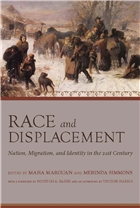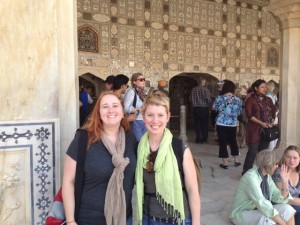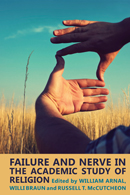 That was the headline of a Huffington Post article yesterday, referring to an op-ed piece in the Des Moines Register, co-authored by three Iowa scholars of religion, all with specialties in biblical studies. The newspaper article they wrote opened by stating:
That was the headline of a Huffington Post article yesterday, referring to an op-ed piece in the Des Moines Register, co-authored by three Iowa scholars of religion, all with specialties in biblical studies. The newspaper article they wrote opened by stating:
Race and Displacement
 Merinda Simmons’s co-edited book, based on a 2009 conference held on the campus of the University of Alabama (of which she was an organizer) that was devoted to the roles of race in such things as displacement, forced migrations, nation and nationhood, and the way continuous movements of people challenge fixed racial definitions, is soon to be published by the University of Alabama Press.
Merinda Simmons’s co-edited book, based on a 2009 conference held on the campus of the University of Alabama (of which she was an organizer) that was devoted to the roles of race in such things as displacement, forced migrations, nation and nationhood, and the way continuous movements of people challenge fixed racial definitions, is soon to be published by the University of Alabama Press.
The Complexities of Justice
Midway through the Sprin g semester of 2013, Leslie Dorrough Smith (on the right of the photo) accompanied a group of undergraduate students from Avila University to a variety of cities in India, including Delhi, Agra, and Jaipur. The study abroad course in which the students were enrolled focused on issues of social justice. Read a post by Leslie here, discussing how, when some people (e.g., North Americans) travel to such locales, they report witnessing exploitation all around (such as the women Leslie reports who would let tourists hold their children for a picture–but for a fee). “We only see it as exploitation,” Leslie concludes, “because we have the luxury of doing so, to put it simply.”
g semester of 2013, Leslie Dorrough Smith (on the right of the photo) accompanied a group of undergraduate students from Avila University to a variety of cities in India, including Delhi, Agra, and Jaipur. The study abroad course in which the students were enrolled focused on issues of social justice. Read a post by Leslie here, discussing how, when some people (e.g., North Americans) travel to such locales, they report witnessing exploitation all around (such as the women Leslie reports who would let tourists hold their children for a picture–but for a fee). “We only see it as exploitation,” Leslie concludes, “because we have the luxury of doing so, to put it simply.”
Holey Frescoes
 Vaia Touna recently published a chapter in Failure and Nerve in the Academic Study of Religion, entitled “Redescribing Iconoclasm: Holey Frescoes and Identity Formation.” The chapter focuses on a small Greek Orthodox church in the upper old city of Thessaloniki,Greece, and the differing local ways in which its damaged interior icons are made meaningful and understood by both its members and the scholars who have restored them.
Vaia Touna recently published a chapter in Failure and Nerve in the Academic Study of Religion, entitled “Redescribing Iconoclasm: Holey Frescoes and Identity Formation.” The chapter focuses on a small Greek Orthodox church in the upper old city of Thessaloniki,Greece, and the differing local ways in which its damaged interior icons are made meaningful and understood by both its members and the scholars who have restored them.
Religious Experience
 Craig Martin and Russell McCutcheon recently co-edited an anthology on religious experience for Acumen Publishing of the UK–or better put, a collection of critical readings that takes the discourse on religious experience as its object of study, inasmuch as all scholars have to study are claims of experience, regardless the sort. And Leslie Dorrough Smith contributed the critical introductions to each reading.
Craig Martin and Russell McCutcheon recently co-edited an anthology on religious experience for Acumen Publishing of the UK–or better put, a collection of critical readings that takes the discourse on religious experience as its object of study, inasmuch as all scholars have to study are claims of experience, regardless the sort. And Leslie Dorrough Smith contributed the critical introductions to each reading.
Changing the Subject
Merinda Simmons‘s first monograph, Changing the Subject: Writing Women across the African Diaspora, has just been contracted by Ohio State University Press. A critique of the scholarly emphasis on authenticity in literary and postcolonial theory, it offers a counterpoint with readings of several African diasporic texts that demonstrate the contingent and contextual frameworks within which categories like “identity” and “voice” are thought to emerge, demonstrating that, instead of being stable, subjects and subjectivities change as they move from place to place.
That Ain’t The Queen’s English
One of the premises of Culture on the Edge is that an implicit, untheorized norm is still presupposed, and its legitimacy is thereby reproduced rather than being historicized, despite many scholars’ recent efforts to develop what they see to be more nuanced, historically sensitive, and situationally specific approaches to identity studies. For it is not uncommon to find seemingly anti-essentialist scholars now studying various identities in terms of their hybridity, seeing them as creoles, studying how diaspora movements have traveled and changed, and documenting the complexity of syncretism–developments understood as important improvements on what are now seen to be previous generations’ far too simplistic studies of social life. After all, as important a an early sociologist as Emile Durkheim seems merely to have understood “society” to be a homogenous, undifferentiated unit. Continue reading “That Ain’t The Queen’s English”
Unsettling Sikh and Muslim Conflict
Katy P. Sian, Unsettling Sikh and Muslim Conflict: Mistaken Identities, Forced Conversion, and Postcolonial Formations (Lexington Books, 2013).
Sian focuses on the process of identification and the ways the interests of those who identify as Sikhs and the context of contemporary Britain generate narratives about “dangerous Muslims” seducing young Sikh women. These narratives address multiple community issues (e.g., shifting gender relations, generational differences, differentiation from a feared Muslim other, alliance with Europeans, etc.). Although a little thin in places, she clearly illustrates Sikh identity as continually constructed, not pre-existing.
A Critical Question
Over at the blog for the Bulletin for the Study of Religion, Merinda Simmons has been among those invited to respond to their query about the line–if any–between scholarship and politics.
It’s Time to Be Honest With Lauryn Hill
Culture on the Edge participant, Monica Miller, recently posted a blog, “It’s Time to Be Honest With Lauryn Hill,” that concludes:
“Over the years, Hill’s lyrical lessons have jolted many from societal slumber and historical amnesia enough to make her a tour de force of the ‘conscious’ hip hop market. But Hill’s troubling portraits of lifestyles not her own are as problematic as the racism and capitalist systems she’s fought for so many years. As she tries to “…figure out how to pay her own tax debts,” may she also realize the expense imposed by her “existential catharsis” on LGBTQ individuals as they continue to fight for justice for their lives and partnerships. As we love to love Hill, let’s love her enough to be honest with her: Enough with responding to one social injustice by perpetuating another. You’re a better MC than that!”
To which Hill responded.


